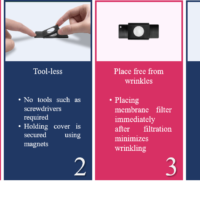Introduction
Transmission measurements are often used in infrared (IR) spectroscopy for qualitative analysis of foreign substances because of the extensive spectral database that is available. However, the surface condition and thickness of the sample must be properly controlled in order to achieve precise measurements. Pretreatment often involves thinning samples using a microtome or slicer, or compressing samples using a press, but these methods require a certain level of proficiency. Therefore, there is a need to simplify this complicated pretreatment process.
For this purpose, JASCO offers the DC-500 diamond compression cell (Figure 1). In this cell, two diamond windows are placed in the centers of a base plate and a pressure plate (Figure 2).
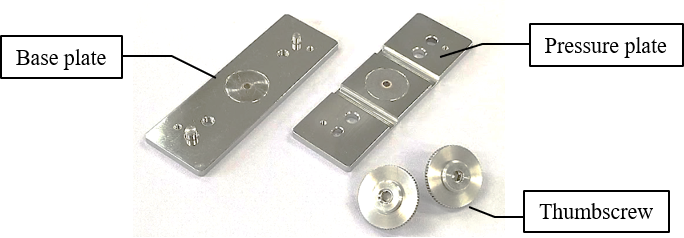
Fig. 1 DC-500 Diamond compression cell

Fig. 2 DC-500 Diamond compression cell
(Enlarged view of area around diamond window of base plate)
The sample is set on the base-plate window, and is then covered by the pressure-plate window to form a sandwich structure. Pressure is then applied using two thumbscrews to compress the sample (Figure 3). This cell makes it possible to measure the transmittance of a sample without the need for pretreatment using a slicer or pressing equipment. Sample preparation does not require any specialized skill, since sample immobilization and compression are performed using only two thumbscrews. This cell can be easily cleaned with organic solvents such as ethanol or acetone because no adhesive is used between the stainless steel and diamond window plates.
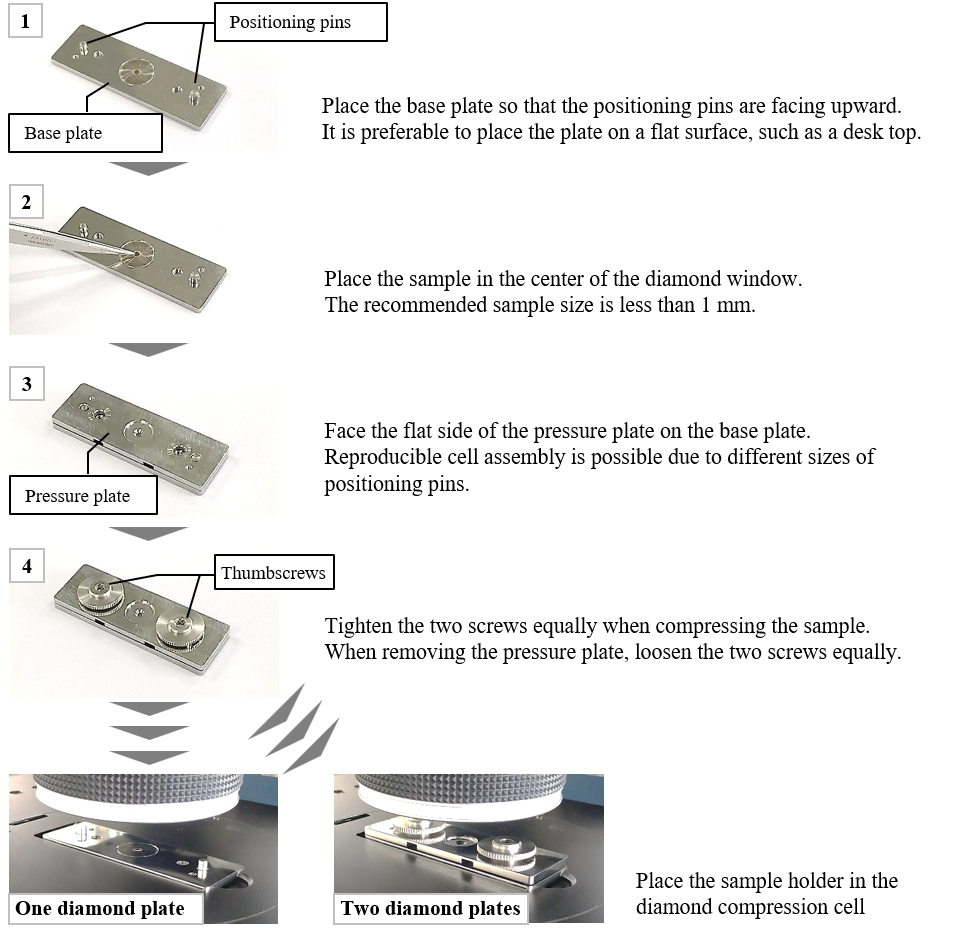
Fig. 3 Procedure for using diamond compression cell
Generally, before performing measurements, the pressure plate with the diamond window is removed after compressing the sample. This is to avoid the occurrence of interference fringes in the IR spectrum due to the gap between the two diamond plates. However, for some types of sample (e.g., rubber-like samples), it is better not to remove the pressure plate, as described later. In this study, three types of sample were prepared for microscopic FT-IR measurements, and the effect of the number of diamond windows used on the qualitative analysis results was investigated.
Specifications of DC-500 diamond compression cell
Diamond window plate: ⌀2.5 mm (diameter for which analysis is valid: ⌀2.0 mm), Thickness 1.0 mm
Pressurization: Hand-cranking using thumbscrews
Diamond properties: Refractive index 2.4, Insoluble in water, Acid and base-resistantNote 1, High mechanical strengthNote 2
Measurement target: General samples, Acid, solvent, and oxidation catalyst samples can also be usedNote 1
Note 1: Although diamond itself can be used for strongly acidic or strongly basic samples, the surrounding metal (stainless steel) holding the diamond plate may corrode. After the measurement, remove the sample and clean the diamond cell immediately.
Note 2: If a strong force is applied to the diamond windows causing them to make contact with each other, the windows may chip.
Experimental
Sample
Ethylene-vinyl acetate: Transparent resin
Polyisoprene: Natural rubber
Calcium carbonate: Inorganic powder
System
Instrument: FT/IR-4X FTIR spectrometer
Accessories: IRT-5200 IR microscope, DC-500 Diamond compression cell
Parameters
Resolution: 4 cm-1
Objective lens: Cassegrain objective 16x
Detector: Mid-band MCT detector
Measurement size: 30 µm x 30 µm
Keywords
Diamond compression cell, DC-500, foreign substance analysis, transmission measurement, pretreatment, FT-IR, FT-IR microscopy
Results
Ethylene-vinyl acetate
A transparent resin, ethylene-vinyl acetate, was measured using either one or two diamond plates (Figure 4).
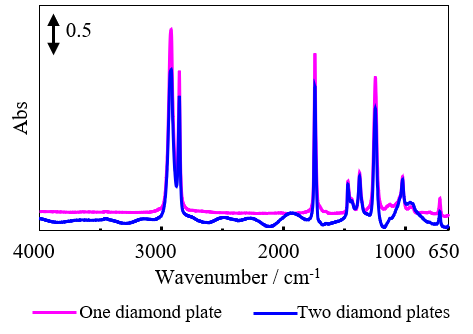
Fig. 4 IR Spectra of ethylene-vinyl acetate
In the case of two diamond plates, interference fringes are observed in the baseline region (blue curve). These fringes are due to light interfering in the gap between the plates. However, it was found that for this sample, removing the top diamond plate did not cause the sample shape to change, and so measurements could be performed using only the bottom plate. The resulting spectrum is seen to be free from interference fringes (fuchsia curve). Thus, a single diamond plate is suitable for measurement of samples whose shape is maintained after compression.
A search was performed using KnowItAll (John Wiley & Sons, Inc.) for the IR spectrum obtained using two diamond plates, in which interference fringes appear (Figure 5).
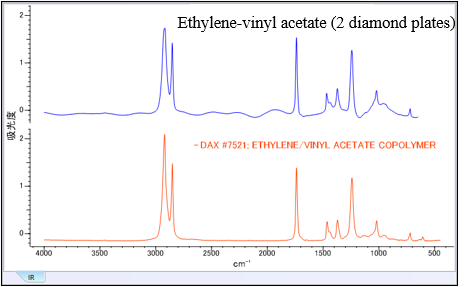
Fig. 5 KnowItAll search results
Since the sample was correctly identified, qualitative analysis is possible even when interference fringes are present if the height of the main peaks is sufficiently large. However, for quantitative analysis where accurately determining peak heights is important, care must be taken because interference fringes can be a major problem.
Polyisoprene
A natural rubber, polyisoprene, was next measured. The results in Figure 6 show that a high-quality spectrum was obtained using two diamond plates, whereas peak saturation occurred when a single diamond plate was used.
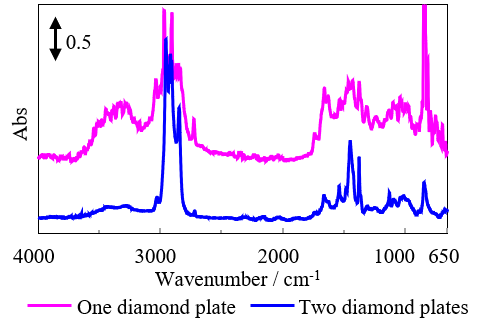
Fig. 6 IR spectra of polyisoprene
Interference fringes, which are clearly seen in Figure 4, are barely visible in Figure 6. Polyisoprene is an elastic sample that will return to its original shape unless it is continuously compressed. For such samples, measurement using two diamond plates is therefore more suitable.
Calcium carbonate
Figure 7 shows IR spectra of an inorganic powder, calcium carbonate, obtained using one or two diamond plates.
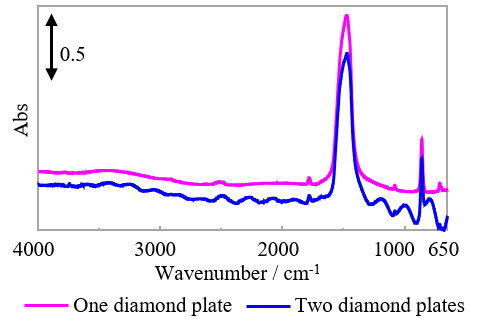
Fig. 7 IR spectra of calcium carbonate
Although interference fringes appear in the case of two diamond plates, their intensity is much lower than in Figure 4. This is thought to be the result of light scattering by the powder sample and the non-parallel state of the diamond plates due to the hardness of the sample, which reduce the degree of interference. Thus, for powder samples that retain their shape after compression, strong interference fringes are unlikely to appear in the spectrum, and so measurements with either one or two diamond plates are possible.
Figure 8 shows the results of a KnowItAll search for the IR spectrum containing interference fringes.
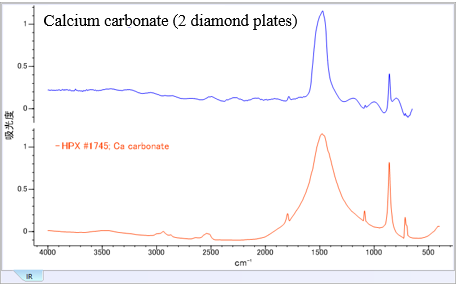
Fig. 8 KnowItAll search results
Again, the sample was correctly identified as calcium carbonate, indicating that qualitative analysis is possible using two diamond plates. For samples such as calcium carbonate that do not adhere to the diamond plate after compression, the use of two diamond plates may be preferable for easier sample handling.
Conclusion
Table 1 shows the recommended use of the diamond compression cell for three different types of sample based on the results of this study. Cases are shown for which it is more appropriate to use one diamond plate due to the influence of interference fringes, when it is better to use two diamond plates due to sample elasticity, and when either method can be used due to the shape and hardness of the sample.
Table 1 Use of diamond compression cell for different samples
| Sample | One plate | Two plates | Example |
| The sample shape is retained even if pressure is not continually applied. | Optimal | Not recommended in some cases | Resins, saccharides, single fibers, etc. |
| The sample shape is not retained unless pressure is continually applied. | Unsuitable | Optimal | Polyisoprene (rubber, etc.) |
| The sample shape is retained even if pressure is not applied continuously, but the stretched surfaces are not parallel or light is scattered by the sample. | Optimal | Suitable | Inorganic powder, fibers |
The JASCO diamond compression cell provides a simple pretreatment method for acquisition of accurate IR spectra of samples with a variety of properties, such as resins, inorganic powder, fibers, and rubber.
We thank Furukawa Electric Co., Ltd. for providing some of the samples and for guidance on the measurement methods used in this report.

